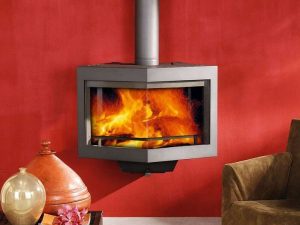We recommend biomass rather than fossil fuels, because it’s more-or-less carbon-neutral (see here for a graph of carbon emissions of various fuels). So for a domestic stove, that’s either logs or pellets. Pellets are made of wood, and although they’re not as prevalent in the UK as the rest of Europe, that market will grow, which means that there will probably be more suppliers and the price will probably fall. The feed of pellets to the fire is usually automated. Logs are simpler and cheaper, and the feed is not automated like pellets, but manual. It might be just down to personal preference, but here are some things to think about.
Logs
Where will you get the wood from? It probably depends on your situation. Are you rural? Do you have trees you can coppice?
Do you know a tree surgeon you can get wood from? Or a sawmill you can get offcuts from? If you live close to a forest, you can offer to take trees down for the owner if you can have the wood. Usually though, you’ll use a local firewood supplier. You can do a web search, look in your local press, ask other people with stoves, or look here.
You’ll have to have somewhere to store your firewood. To heat one room, using nothing else but a stove, you’ll probably need around 5 tonnes of wood a year (less if it’s a small room), or around 10 for the whole house (these are ballpark figures obviously – it depends on the wood, how well insulated your house is, the size of your room/house, how you like the temperature etc. – but that’s a rough guide). One tonne of wood is around 3-4 pickups full, or 3-4m². The wood needs to be covered, but with a good air flow. If you’re getting seasoned wood, or even to check the wood you’ve stored, a moisture meter might be a good investment.
Videos: moisture content of firewood explained, part 1 and part 2
Unseasoned wood is cheaper, so if you buy unseasoned, you need to store twice as much wood as you’ll need for the next winter, so that half of it has a year to dry before use. Oak needs two years to dry; ash and pine will dry over one summer. It’s also cheaper to get cordwood and chainsaw and split it yourself. You have to have the space, the inclination, the equipment and the skills to do this of course.
Pellets
Pellets are 6-8mm diameter, made by putting sawdust in a mill (like making mincemeat). The sawdust is forced through little holes, which melts the lignin in the wood and binds the pellets together. There’s no glue involved.
The pellet feed to your fire can be automated. You turn it on, programme it and forget it. There is an electric heating element, and air is blown over it to start the fire.
It’s important to get the quality of the pellets right. Cheaper pellets could contain more bark, will burn more quickly and produce less heat per kg – so they won’t really work out cheaper in the end. You can get quality ratings for wood pellet suppliers from Woodsure, and here’s another list of suppliers. Pellets can be supplied in 15kg bags, or delivered by truck into a hopper.
Thanks to Sune Nightingale of Stoves Online.

